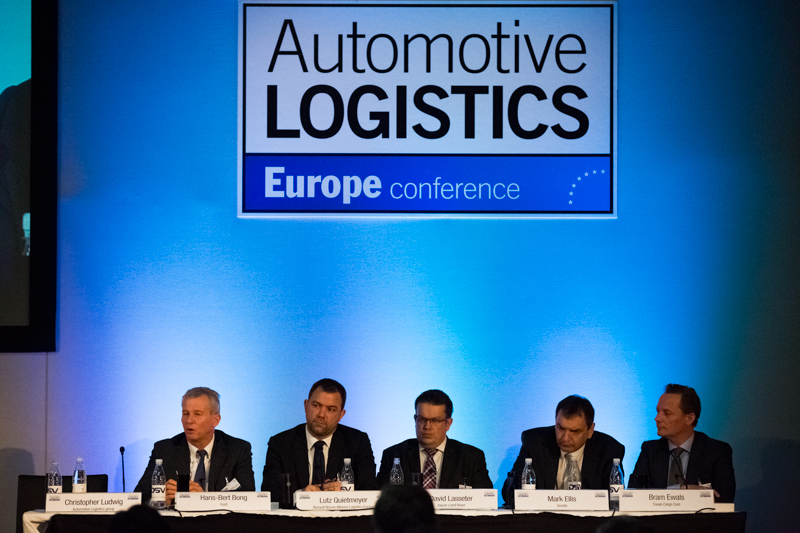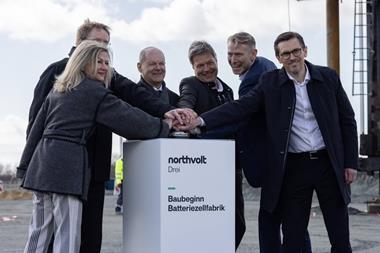Delegates gathered in Bonn, Germany for the annual Automotive Logistics Europe conference, where senior executives discussed the role of technology, e-commerce and globalisation in the automotive supply chain. Some of the forecasts were scary, although many foresee increasing complexity and opportunity – if logistics companies can keep up with the changes, writes Christopher Ludwig. With Marcus Williams and Rachael Hogg.
Those attending the Automotive Logistics Europe conference in Bonn, Germany were faced with weighty, even existential questions about the future of the industry, starting with current and future changes in demand for new vehicles in Europe, right through whether changing technology such as driver automation, connected vehicles and 3D printing might drastically change, or even eliminate, some of the current ways that carmakers manage their supply chains or that logistics providers earn a living.
While the degree and speed in which industry executives will confront these changes remain to be seen, the conference also heard about current challenges in logistics that were as familiar as they are significant, including increasing complexity in part numbers and flows, changing geographies, rising data flow, changing regulations, and, of course, the need for ever greater operational efficiency.
The European Union has returned to a slow growth in new vehicle sales and stronger vehicle production, although the rates of recovery and momentum vary widely by region and OEM, according to Christoph Stürmer, global lead analyst for PwC’s Autofacts. Thanks in part to strong demand in North America and China, PwC predicts that production in the European Union will expand 5% in 2015 compared to 2014 to close to 18m units.
EU passenger vehicle sales rose for the first time in seven years in 2014 to 12.5m units, with commercial vehicle sales up 7% to around 1.8m units. This year vehicle sales are predicted to grow just 3% from these relatively low levels.
See stories below for more coverage from Automotive Logistics Europe 2015
- Overcapacity is driving down logistics pricing
- Keeping pace with e-commerce and technology in aftermarket
- BLG using IT to challenge status quo
- JLR will use telematics for vehicle logistics
- CTM signs deal with Inform
- Joined up thinking needed for greener vehicle logistics
- LSPs stand to gain a greater share of the value chain
- Managing supply chain sustainability
- Panel discussion: the future of logistics
This compares to an overall logistics market that remains sluggish globally and growing at a slow, single digit pace in Europe, according to Thomas Cullen, chief analyst at logistics consultancy Transport Intelligence. Stripping out the UK and Germany from the retail industry in Europe, for example, reveals a “horrible” market. Road freight across the continent has grown by only a cumulative 16% in ten years, he pointed out, with considerable volatility. “Air freight and container shipping are a mess,” he added.
While the overall growth has certainly been welcome following years of decline in automotive volume across Europe, it was difficult to avoid some of the wider risks and changes that the European industry is facing. Russia’s economic fallout, along with its geopolitical tensions with the Ukraine, EU and the US, pose a threat to growth and stability that is increasingly impossible to predict. More broadly, changing demographics, including an ageing population and increasing urban population, are shifting patterns of vehicle use.
These changes may well combine with the emergence and integration of networked, automated driving technology to transform the motor vehicle and its supply chain, as well as human interactions with it. An interesting, if not foreboding example came from guest keynote speaker Chris Bangle, former chief of design for the BMW Group, who today runs his own studio in Italy, Chris Bangle Associates. Bangle, a famously provocative and daring designer, pointed to the risk of emotional disengagement with cars in favour of mobile and smartphone technology, particularly among today’s youth. At the same time, he critiqued the industry’s rush towards mediocrity and standardisation in vehicle design, with many manufacturers copying familiar looks and patterns, warning that it could lead to further disengagement with vehicles.

A supply chain with fewer moving parts
More specific to logistics and the automotive supply chain itself, this version of the future could bring with it other changes that would render parts of today’s automotive logistics industry redundant. For example, logistics itself could become even more commoditised should tasks such as pickup, delivery and handling become almost entirely automated.
Meanwhile, the number of moving and mechanical parts in a vehicle could be replaced with electronics and software, changing many assumptions about the supply chain. Nick Beard, director of automotive at TNT, suggested that vehicle diagnostics and 3D printing could one day greatly reduce how customers interact with dealers for spare parts, and thus the amount of material that logistics providers deliver.
“As logistics people, can you imagine if everyone ended up with a Tesla? Our business would collapse,” said Beard. “Although I admire what Tesla are doing, we’re going to have to change within our network. How can we move this safely and at the right cost?”
According to Alfonso Serrano, head of instock management for automotive at online retailer Amazon, online aftermarket sales are expected to more than double in the next ten years, and by 2025, will account for 20% of total aftermarket sales.
“Retail has evolved from the physical space to an online marketplace,” he said. “In this change, manufacturers and brands have more opportunities to be closer to their customers and promote their brand and products.”
Peter Fuß, senior advisory partner for automotive at consultancy EY (Ernst and Young), pointed to new players, from smartphone companies to robot manufacturers, that could get involved in supplying the automotive industry. Meanwhile, some players in the sector today could become irrelevant.

The internet of automotive logistics things
The conference did not only present bleak visions of the future. There will also be plenty of opportunities for carmakers and logistics providers to harness new technologies and the internet to improve productivity, visibility and efficiency. Peter Fuß said that the emergence of new supply chain players would allow existing companies, such as logistics providers, to increase their portfolio and products. He pointed out how ZF’s takeover of TRW was a specific move to gain more control and expertise in sensor technology and driverless cars.
Meanwhile, new technology could also bring opportunities for tremendous gains in logistics improvements and cost reductions. Clearly, a truck with significant automation could help logistics companies move longer and further without violating driving regulations, and reducing accidents caused by human error.
Marco Freund, head of openID centre at Germany’s Fraunhofer IML, a logistics research organisation, also pointed to projects and equipment that were being developed that would introduce the ‘Internet of Things’ into automotive warehousing and factories, such as Google Glass wearable technology that could communicate between people, inventory management and material handling equipment. Examples of innovations that he described included iBins, which could record, count and photograph the parts it contains, connecting directly to the cloud. He also described a ‘smart kanban’ system that could scan, record and signal items automatically.
Likewise, Freund revealed existing technology such as fleets of driverless shuttles and handling equipment that could flow across warehouses and plant floors, further increasing automation and reducing errors. Fraunhofer recently won an award from the Volkswagen Group for developing a small drone helicopter that could fly around warehouses and use RFID scanning to communicate with returnable packaging equipment and inventory management systems.
A future more mundane, but more complex
Of course, any prediction of the future can by its nature be speculative and liable to a certain amount of hyperbole. While many executives leading the operations and management of today’s automotive supply chains recognised that major changes were on their way, they seemed to be expecting neither a total transformation of the supply chain into drones and automated vehicles, nor were they forecasting their own demise any more than those of logistics providers.
Rather, global growth in vehicle production and sales continues to power ahead, while carmakers are investing billions into new plants, networks and logistics across the world. Europe will continue to play a major role in the supply chain. PwC’s Stürmer predicted that the EU would add 2.1m units more in production by 2021, including half a million units more capacity in Germany. By then, he also expected that Russia would have moved out of the current crisis, increasing production by 1.2m units.
"Think about cars with no combustion engine, no transmission, built with a 3D printer, and which can largely repair themselves with updates. That will impact the logistics industry, too." - Peter Fuß, EY
A growing diversity of models and derivatives, particularly among premium manufacturers in Europe, is also driving complexity in the supply chain and at the line side, increasing demand for packaging, logistics engineering and material handling services. Many executives and experts see more opportunities for supply chain growth and services, rather than fewer, and they especially believe that logistics and supply chain expertise among manufacturers and logistics providers would become even more important.
Andreas Ginkel, director of alliance logistics at General Motor’s Adam Opel division, admitted that some of the challenges that have been cited in the automotive supply chain for the past 20 years, including poor forecasts, changes to production schedules, and the need to run large, competitive transport tenders, are likely to remain major issues for the next 20 years as well. However, it will be important for logistics providers to ready themselves to play a larger role in managing and dealing with the complexity around all of these issues, regardless of the type of technology, systems and equipment that may be required.
“Help us to manage that complexity and let us get together with the huge intelligence in this industry and have the right organisation, people and processes that can talk about who needs to do what in the end-to-end chain, with a complete customer focus and vision of total enterprise cost,” he told delegates. “In that way, the nucleus of the past and the future is the same.”

Geert Bruyneel, vice-president of logistics and supplier quality for the Volvo Car Group, suggested that today’s already complex systems and processes were going to get even more so over the coming years with an exponential growth in technology changes, globalisation and regulation. But he still saw human management skills and intelligence as the driving force in handling this complexity.
“People are still going to be the most critical element, and having the right competences and talent will remain critical,” he said. “We can help by setting up simple principles because we have to be able to manage change, and so that means staying with strategies such as build where you sell, and source where you build. Think global and act local, that will become exponentially more important.”
Learning from e-commerce
But there was frustration, too, about whether the automotive industry is as quick to adapt to changes in technology as other sectors, whether that means using RFID or automated equipment, or in using the supply chain as a competitive advantage. Transport Intelligence’s Thomas Cullen pointed out that while the automotive sector was probably still the leading industry in executing operational quality in its logistics, such as low damage rates, stable processes, quality control and just-in-time production, he questioned whether the sector had really kept up with e-commerce companies such as Amazon and Alibaba that probably spend more on logistics and technology across their supply chains.

“These companies have vast facilities in regional centres, which act as key logistics nodes, even if the stuff is sourced globally,” he said. “Amazon and others have created huge economies of scale to utilise the new technology and potential of information technology. They use AGVs on a huge scale that allows them to reclaim the capex, for example. It’s an information business, which is central to their business at all levels, and that drives logistics productivity.”
Cullen was less convinced that the automotive supply chain, which still tends to build its supply chain most around the factory, was as global and strategic in using global logistics to compete. Likewise, the investment in technology like AGVs or other types of automated sortation was not as prevalent in parts-related warehousing as it might be found in retail or e-commerce logistics.
“I don’t know that the automotive supply chain is really taking a leading role in what German academics call ‘Industry 4.0’,” he says, referring to how the ‘Internet of Things’ was expected to transform industrialised economies.
He did add, however, that things were far from perfect within e-commerce. He described warehouses that he had visited in which sofas had been stacked one on top of another, and in which some inventory was managed by handwritten notes. Likewise, the ‘last mile’ remains a “mess”, not only in delivery practice but also in dealing with unprofitable return logistics.
"Amazon and others have created huge economies of scale to utilise the new technology and potential of information technology. They use AGVs on a huge scale that allows them to reclaim the capex... It’s an information business, which is central to their business at all levels" - Thomas Cullen, Transport Intelligence
Dror Noach, vice-president of logistics services at CNH Industrial, which includes CNH agriculture equipment, powertrain and Iveco trucks, agreed that there was much to learn from the e-commerce sector, and that he ultimately saw more similarities in the automotive supply chain than differences, whether the processes were pick, pack and ship or built around assembly.
“I see a lot of similarities. And both need to be focused on serving the end customer.”
Volvo Cars’ Bruyneel, who has a background in manufacturing and plant operations, noted huge room for improvement in lean processes and applications in inbound and outbound logistics, particularly compared to plant flows.
“From my perspective, compared to in-plant production, there is still a big gap in operational excellence for inbound and outbound. We need to take advantage of technological development, but we should not forget the daily improvements with processes and people. There is still a big potential in that respect,” he said. “We want to create a seamless flow without interruption with perfect sequence, high build-to-order ratios and high resource efficiency.”
Carlos Lahoz, general manager for business planning and the supply chain at Kia Europe, agreed that implementing new systems, process and equipment in the supply chain often went slowly, requiring years for real change to be instituted. “I would like as a customer or client to find the supply chain solutions more quickly,” he said.
Barriers to change clearly remain. Some executives resisted comparisons to Amazon and e-commerce logistics, pointing to the different demands and complexities of the automotive industry. Other admitted that thin margins and cost pressures meant that return-on-investment cycles remained short, preventing some companies from implementing new technologies as quickly as the software or high technology sectors might. Bruyneel admitted that he would have no problem convincing top management to approve an IT or equipment project that paid back its investment in 3-6 months. However, those that require 1-3 years were a much harder sell.
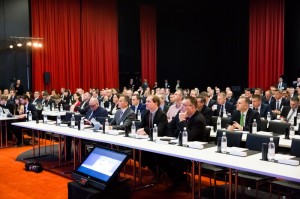
“We are trying to incorporate with all stakeholders, logistics, engineering, financing. We have a process in place where different parties work on specific topics, including a bill of material implications and locations. But we are not where we would like to be yet.”
Going end to end for improvements
There were other examples where manufacturers and logistics providers have invested in fixing some chronic problems. Ginkel emphasised how GM was making a much more concerted effort to carry out more “end-to-end” supply chain design, including considering things like container conveyances as early as a vehicle’s planning and launch phase. An order slotting system recently integrated in Europe has also been helping to improve efficiency across the supply chain, including by providing real time updates to material orders and changes to forecasts into the carmaker’s bill of material scheduling.
Dror Noach also emphasised how CNH Industrial is doing more to design end-to-end supply chains. The company has tried to facilitate this through a new IT platform that connects the supply chain in all its regions globally, except for Asia Pacific. “You have to consider the supply chain a full process from design through to the aftermarket. If you make a change in the plant, you have to make sure you follow that change through to sequencing, warehouses and logistics providers,” he said. “Today we have designers who are working specifically on what the implications are for logistics on the products we’re developing today.”
Noach also pointed to examples of how cost pressure forced CNH to move more quickly in IT and new logistics solutions, including using data on transport rates to create and engineer its own fleet of trucks in one region.
“We took all the information from our Oracle Transport Management, and matched all the rates we had in the system. We discovered that if we would deploy 43 trucks full time, we could reduce empty kilometers,” he said. “So, we rented those trucks and deployed the brain of the system to tell them where to go. We counted on our ability of crunching the numbers and coming up with those solutions.”
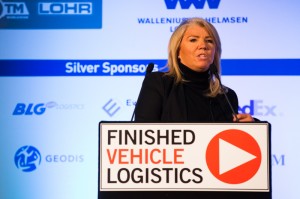
JLR is also using geofencing technology to get real time track and trace information and key updates on compound location (to within two parking spaces), as well as where vehicles are at port of entry and exit, and when they have been delivered to the dealer.
Buswell explained that the telematics technology is put in at the beginning of the vehicle’s life. From there on it talks to a cloud service passing on data directly to Jaguar Land Rover and onto the company’s telematics service provider, which in turn has contact with the carmaker and its dealers.
“Real time track and trace using telematics has been delivered,” said Buswell. “Real time vehicle diagnostic alerts are in place, and there is development and integration of this technology.”
Keeping up with opportunities
Even outside the pure scope of technological change and innovation, the conference reminded delegates that plenty of new business remains for logistics providers and supply chain experts of all kinds. JLR’s David Lasseter pointed to the carmaker’s growth in UK production, including its new engine plant, as presenting more opportunities for input and improvements from logistics providers. “We are looking to work in partnership with our logistics providers,” he said.

“With new, global products coming into our plants in Valencia and Saarlouis, Germany, we are also seeing more global parts, including a large amount from North America,” said Bong. “This is driving growth in things like customs, as well as presenting challenges in obsolescence and production planning. We require better visibility and logistics planning to help mitigate this. These are opportunities for logistics providers.”
Lutz Quietmeyer, general manager for inbound logistics at Renault-Nissan, also pointed to the tremendous complexity that the company sees in managing not only production and supply networks between the two main brands of the alliance, but also in its other vehicle assembly and powertrain partnerships, including with Daimler, Opel, Fiat and Avtovaz. He said that the carmaker wanted to build in more flexibility in its logistics, as well as more multimodal options.
“We are looking for alternatives and new ideas,” he said.
Experts also see rising demand in Europe for complex, analytical services and intelligence in the supply chain. Bram Ewals, chief executive officer at road and intermodal provider Ewals Cargo Care, said that he was looking for new skills and talent to recruit in his company, whether in IT or economics.
“We’re seeing more demand for ‘orchestration’ in the supply chain, where manufacturers rely on us to come up with more complete solutions. For that, we require a high degree of training and advanced skills for our people,” he said.

“There will be new ways of distributing vehicles, but what it will be exactly, none of us know. The only way of avoiding being Kodak is to go quickly and to understand and adjust to these movements,” he says.
Ray Fitzgerald, president of the Americas, Europe, Middle East and Africa at WWL, also noted that technology could be an enabler of growth and improvement in logistics, but only if the right people with the right support were available to use it. He described how organisations needed to support and train employees to be able to anticipate and respond to changes in the automotive industry, whether that is vehicle automation or 3D printing. “We think that leadership will be completely changed in this industry,” he said.
Frank Vorrath, vice-president and global automotive head at DHL Global Forwarding, highlighted not just the need but also the urgency for training and development in the automotive logistics sector. A white paper commissioned by DHL has revealed a looming talent crisis in the European automotive logistics industry with an ageing work population, as well as a shortage of skills in certain key, emerging markets. “We need to work together across the industry to train young talent if we are going to avoid a talent gap,” he said.
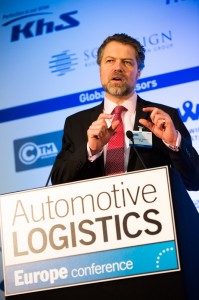
“Suppliers and logistics providers cannot just be order takers anymore, but an integrated part of the value chain,” he said. “Transport is just one part of the entire logistics sphere, and those that thrive will be those who are specialists in automotive as well as in logistics. You need to have a deeper understanding.”
Videos from this and other principal sessions are avaible on the programme page here.
The next conference in the global Automotive Logistics series will be in China in Shanghai April 14-16th. See more details here.

















